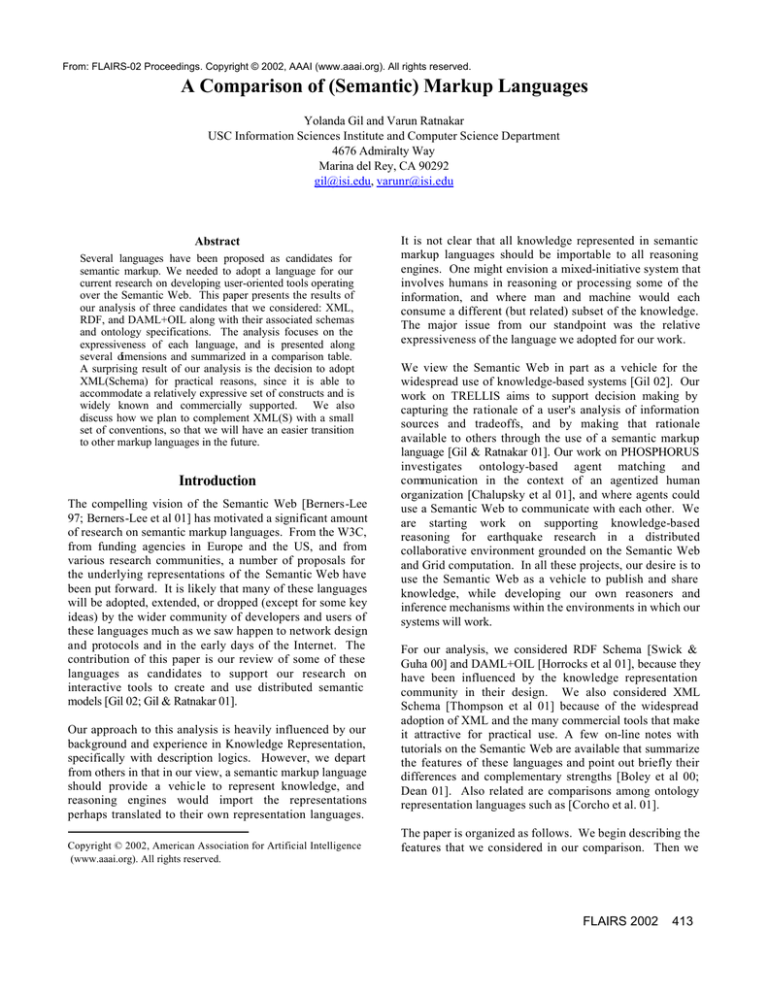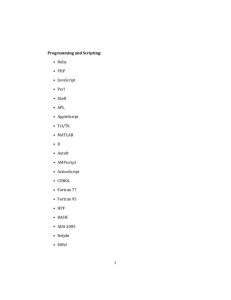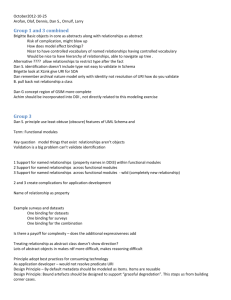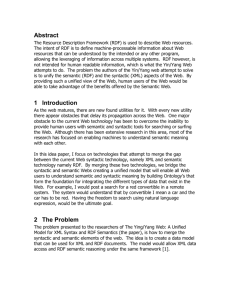
From: FLAIRS-02 Proceedings. Copyright © 2002, AAAI (www.aaai.org). All rights reserved.
A Comparison of (Semantic) Markup Languages
Yolanda Gil and Varun Ratnakar
USC Information Sciences Institute and Computer Science Department
4676 Admiralty Way
Marina del Rey, CA 90292
gil@isi.edu, varunr@isi.edu
Abstract
Several languages have been proposed as candidates for
semantic markup. We needed to adopt a language for our
current research on developing user-oriented tools operating
over the Semantic Web. This paper presents the results of
our analysis of three candidates that we considered: XML,
RDF, and DAML+OIL along with their associated schemas
and ontology specifications. The analysis focuses on the
expressiveness of each language, and is presented along
several dimensions and summarized in a comparison table.
A surprising result of our analysis is the decision to adopt
XML(Schema) for practical reasons, since it is able to
accommodate a relatively expressive set of constructs and is
widely known and commercially supported. We also
discuss how we plan to complement XML(S) with a small
set of conventions, so that we will have an easier transition
to other markup languages in the future.
Introduction
The compelling vision of the Semantic Web [Berners-Lee
97; Berners-Lee et al 01] has motivated a significant amount
of research on semantic markup languages. From the W3C,
from funding agencies in Europe and the US, and from
various research communities, a number of proposals for
the underlying representations of the Semantic Web have
been put forward. It is likely that many of these languages
will be adopted, extended, or dropped (except for some key
ideas) by the wider community of developers and users of
these languages much as we saw happen to network design
and protocols and in the early days of the Internet. The
contribution of this paper is our review of some of these
languages as candidates to support our research on
interactive tools to create and use distributed semantic
models [Gil 02; Gil & Ratnakar 01].
Our approach to this analysis is heavily influenced by our
background and experience in Knowledge Representation,
specifically with description logics. However, we depart
from others in that in our view, a semantic markup language
should provide a vehicle to represent knowledge, and
reasoning engines would import the representations
perhaps translated to their own representation languages.
Copyright © 2002, American Association for Artificial Intelligence
(www.aaai.org). All rights reserved.
It is not clear that all knowledge represented in semantic
markup languages should be importable to all reasoning
engines. One might envision a mixed-initiative system that
involves humans in reasoning or processing some of the
information, and where man and machine would each
consume a different (but related) subset of the knowledge.
The major issue from our standpoint was the relative
expressiveness of the language we adopted for our work.
We view the Semantic Web in part as a vehicle for the
widespread use of knowledge-based systems [Gil 02]. Our
work on TRELLIS aims to support decision making by
capturing the rationale of a user's analysis of information
sources and tradeoffs, and by making that rationale
available to others through the use of a semantic markup
language [Gil & Ratnakar 01]. Our work on PHOSPHORUS
investigates ontology-based agent matching and
communication in the context of an agentized human
organization [Chalupsky et al 01], and where agents could
use a Semantic Web to communicate with each other. We
are starting work on supporting knowledge-based
reasoning for earthquake research in a distributed
collaborative environment grounded on the Semantic Web
and Grid computation. In all these projects, our desire is to
use the Semantic Web as a vehicle to publish and share
knowledge, while developing our own reasoners and
inference mechanisms within the environments in which our
systems will work.
For our analysis, we considered RDF Schema [Swick &
Guha 00] and DAML+OIL [Horrocks et al 01], because they
have been influenced by the knowledge representation
community in their design. We also considered XML
Schema [Thompson et al 01] because of the widespread
adoption of XML and the many commercial tools that make
it attractive for practical use. A few on-line notes with
tutorials on the Semantic Web are available that summarize
the features of these languages and point out briefly their
differences and complementary strengths [Boley et al 00;
Dean 01]. Also related are comparisons among ontology
representation languages such as [Corcho et al. 01].
The paper is organized as follows. We begin describing the
features that we considered in our comparison. Then we
FLAIRS 2002
413
present a table that summarizes the results of our analysis
and comment in detail the entries on the table.
Dimensions for Comparison
In this section, we give a list of dimensions that we thought
were useful in comparing languages for the Semantic Web.
§ Context: Modularity is an important consideration,
especially in large distributed environments. The same
term should be interpreted according to the context in
which it is defined. The same term can be defined
differently in alternative contexts. It is important that
the language can express the different contexts in
which terms should be interpreted.
§ Subclasses and properties: These express relations
between object classes. Subclasses represent "is -a"
relations. Properties relate different object classes.
Classes and properties are sometimes called concepts
and roles, or frames and slots, objects and attributes,
or collections and predicates.
§ Primitive data types: A common set of primitive data
types, such as strings and numbers, that can be used
directly or to compose new complex types.
§ Instances: These objects denote individuals, which can
be described in terms of their properties or specified to
be members of a class.
§ Property constraints: These constraints define each
property. The domain specifies the classes that can
have that property. The range indicates the classes
that can be used to assign values to the property.
Cardinality constraints restrict the cardinality of the
range, i.e., how many values can be assigned.
Properties can be described with respect to a specific
class, which means that the property can only be
described or used for that class. Properties can also be
described as independent entities, which means that
any classes that satisfy the constraints can be related
with that property even if this is not indicated in the
class definition.
§ Property values: In addition to range and cardinality, the
values that can be assigned to a property can be
restricted further. A default value can be provided. A
enumeration of possible values may be given as a set
of choices. Ordered sets specify the order of the
elements, either extensionally or intensionally.
§ Negation, conjunction and disjunction:
Negated
statements of any description allowed in the language
are often useful, but the computational cost is steep
and as a result only limited forms of negation are
typically supported in a given language. Disjunctive
expressions are often used to describe relations among
subclasses or property constraints.
414
FLAIRS 2002
§ Inheritance: Inheritance indicates that the constraints
and values of properties in parent classes are true of
the subclasses. Multiple inheritance allows inheritance
from multiple parent classes.
§ Definitions: Whether necessary and sufficient
conditions for class membership can be specified. The
system can use these definitions to reason about
class-subclass relations (subsumption) and to
determine whether instances are members of a class
(recognition), as in description logic systems.
There are other dimensions with respect to expressiveness
that could be considered, but these are the main ones that
we were concerned about for our work.
Analysis and Comparison
We analyzed and compared RDF Schema and DAML+OIL
along the dimensions stated above. We also compared
XSD, the XML Schema Definition Language, so we could
understand better its features and limitations, even though
it was not designed as a semantic markup language. Notice
that the three languages are closely related. XML is used as
a syntax for RDF. RDF is not only used as a syntax for
DAML+OIL, but also as a sublanguage since some
expressions are written in RDF (e.g. instances).
It is important to note that each language is in a different
state of development. We used the XML Schema
Definition Language [Thompson et al 01], which is now a
recommendation of W3C and thus effectively a standard.
We used the RDF Schema Specification 1.0, which has a
Candidate Recommendation status in W3C and is still
undergoing major modifications. We used the DAML+OIL
version of May 2001, which is one of the initial proposals of
a language that will continue to be extended and modified
in the coming years.
We have not included in our analysis other alternative
languages for semantic markup, such as topic maps and
XQUERY. A very active area of work is the development of
languages to express and reason about services on the
Semantic Web such as WSDL and DAML-S, which we
have not included in the analysis presented here.
The analysis and comparison is presented in Table 1. The
table is available on-line [Ratnakar and Gil 01], including
detailed examples of descriptions in each language and
pointers from every entry to the specific portion of the
examples that illustrate the usage for that particular
language. The rest of this section describes the results of
our analysis and comparison in detail for each of the
dimensions described above.
Dimension
Contexts
Details
Contexts
Object Classes
& Properties
Classes
Inheritance
XML Schema (2001)
Yes
No
(A Class could be any
element & its property
could be its child element
– NO DEFINED
SEMANTICS)
No
(Although we may extend
element Types)
Property
Yes
/Element Range (Global & Local)
Property
/Element
Constraints
Data Types
& Instances
Data Sets
Property
/Element
Domain
Yes
(Properties and Classes)
(rdfs:subClassOf,
rdfs:subPropertyOf)
Yes
(Global only – rdfs:range)
Property
/Element
Cardinality
Yes
Yes
(implicitly, the element in (Global only) rdfs:domain
which the ‘property
element’ is defined)
Yes
No
(Local only – minOccurs,
maxOccurs)
Negation
No
Yes
(Properties and Classes)
Uses RDF syntax
Yes
(Global – rdfs:range &
Local – daml:Restriction ,onProperty,
toClass)
Yes
(Global) – rdfs:domain
Yes
(Local – minCardinality, maxCardinality,
cardinality &
Global – UniqueProperty, or Restriction
a subClass of “#Resource”)
Basic Datatypes Yes
No
Yes
Variations of numerical, Only Literals (this version) Allows the use of XMLSchema
date and string datatypes.
Datatypes
Enumeration of Yes
No
Yes
Property
<enumeration>
<daml:oneOf>
/Element Values
Can also point to XMLSchema
enumeration datatype
Instances
Yes
Yes
Uses RDF syntax
<rdf:ID>
Bounded Lists No
No
Yes <daml:collection>
Ordered Data
Yes
Yes
Yes
Sets
Data Sets maintain order <rdf:Seq>
<daml:list>
by default
Negation,
Disjunctive
Disjunction & Classes
Conjunction
Conjunctive
Classes
Nec. & Suff.
Cond.’s for
Definition
Membership*
Inverse
Types of
Properties
RDF Schema (2000)
DAML+OIL (2001)
Yes
Yes
Yes
Yes
(rdfs:Class & rdfs:Property) (daml:Class,
daml:ObjectProperty,
daml:DatatypeProperty)
Transitive
No
Yes
<daml:ComplementOf>
No
No
Yes
(although we can have
<daml:disjointUnionOf>
unions of element Types)
<daml:unionOf>
No
Yes
Yes
Multiple <rdf:subClassOf> <daml:intersectionOf>
No
No
Yes
(however, <unique> could
<daml:sameClassAs>
be interpreted as an
<daml:UnambigousProperty>
‘Unambigous Property’)
No
No
Yes
<daml:inverseOf>
No
No
Yes
<daml:TransitiveProperty>
Table 1. Comparison summary
FLAIRS 2002
415
Contexts
Namespaces [Bray et al. 98], one of the most elegant
features adopted by the XML standard, can be used as a
limited form of context.
This is done using the
<xmlns:*label*=“URI”> tag, where *label* is the prefix used
to refer to elements in the particular context specified by the
URI. <xmlns=“URI”> specifies the default namespace when
the prefix is omitted within the document. A very subtle but
important point is that the URI specified in the tag is not
required to point to a schema that defines the terms to be
used in that namespace, and so effectively the tag just
provides a label to refer to the context. To specify the
location of a schema to be used to interpret the terms, the
tag <xsi:schemaLocation> must be used. In summary,
namespaces by themselves provide a very simple notion of
context, and only the additional specification of a schema
location provides the definitions of terms.
RDF uses XML namespaces to refer to schemas. An
important difference from XML is that the namespace URI
reference also identifies the location of the RDF schema.
Thus, the use of namespaces in RDF seems to be a more
clean mechanism to represent contexts.
DAML+OIL also uses XML namespaces. Unlike RDF, the
schemas (called ontologies) specified in a namespace tag
are not used. In order to use their definitions, they have to
be explicitly imported using the <daml:imports> tag.
Classes
In XML(S), there are no explicit constructs for defining
classes and properties. There are only elements and
subelements, which can be given an ad-hoc interpretation
as a class/subclass or as a class/property statement.
However, lack of a standardized way to represent classes
and properties in XML results in ambiguity when mapping
from the XML data model to a semantic model. XML allows
the definition of new types by extending or restricting
existing simple or complex element types. However, the
extended and restricted types are not subclasses of the
types used in their definition.
RDF Schema provides explicit tags to define new classes
and properties. Classes can be specified with the
<rdfs:class>.
Subclasses and subproperties can be
specified
using
<rdfs:subClassOf>
and
<rdfs:subPropertyOf> (the top class defined in the schema
is Resource). When a class is a subclass of several superclasses, this is interpreted as the conjunction of the superclasses. Cycles in the class hierarchy are not allowed,
however class equivalence can be specified through
cyclical descriptions (Note: Future versions are expected to
change this and allow cycles). The RDF Schema definition
may be revised and this could change in the near future.
416
FLAIRS 2002
DAML+OIL allows cycles in the class hierarchy. It allows
definitions of subclasses using the <daml:subClassOf> tag.
DAML+OIL classifies properties into Object Properties
(that relate a class to another class) and Datatype Properties
(that relate a class to a primitive data type), whereas RDFS
makes no such distinction.
Data Types and Instances
XML Schema offers a wide range of data types, compatible
with databases. DAML+OIL adopts the primitive data
types of XML Schema, whereas RDF provides only literals
(strings). Instances in DAML+OIL are specified using RDF
syntax.
Property Constraints
XML Schema provides range constraints on elements by
the “type” attribute of the element definition. The domain of
an element is implicitly the parent element within which it is
defined or referred to. A property, and hence its range, is
global if the property (or element) is a top-level element (no
parent elements), otherwise it is local. Local cardinality
constraints on properties can be specified using
“minOccurs” and “maxOccurs” attributes while referring to
the property inside a parent element. However, it is not
possible to define cardinality constraints globally. Note that
XML has elements and attributes, so the support for
properties is not part of the XML Schema definition.
RDF Schema allows range and domain constraints on
properties, which are declared globally. Multiple range
statements, which were not allowed until recently, imply
conjunction, as do multiple domain statements, i.e. all of the
constraints have to be satisfied. RDF Schema does not
provide cardinality constraints in its specification.
DAML+OIL specifies similar semantics for multiple range
and domain statements as in RDF Schema. DAML+OIL
however also allows for local range constraints using:
<rdfs:subClassOf><daml:Restriction>
<daml:onProperty…/><daml:toClass.../>
</daml:Restriction></rdfs:subClassOf>
The <daml:Restriction> tag forms an anonymous class
consisting of all instances that satisfy the restriction.
Property Values
Elements are by default ordered in XML. However, we can
impose a particular order on the occurrence of elements in
XML Schema by the <xsd:sequence> tag.
In RDF, we can order a set by using the <rdf:Seq> tag. We
can use the same in DAML+OIL.
Neither XML Schema nor RDF provides constructs for
defining a bounded list. DAML+OIL has a tag
<daml:collection> which specifies this.
Negation, Conjunction and Disjunction
Only DAML+OIL supports some kind of negation and
disjunction, through <daml:complementOf> (negation) and
<daml:disjointUnionOf> (disjunction). XML Schema also
provides a <union> tag which gives the disjoint union of
various element “types”. Conjunction is supported in
DAML+OIL through the <daml:intersectionOf> tag, while
multiple <rdfs:subClassOf> tags imply conjunction in RDF
Schema.
Definitions
Necessary and sufficient conditions for class membership
can be expressed with <daml:sameClassAs>. Another
interesting tag is the <daml:UnambigousProperty> tag
which uniquely identifies the resource from the property
(like a primary key). There is also a <unique> tag in XML
Schema which is similar to the UnambigousProperty tag.
Types of Properties
DAML+OIL supports different types of properties. A
property can be defined in DAML+OIL as ‘InverseOf’
another property. A property can also be defined as a
‘TransitiveProperty’.
Discussion
An important difference among these languages is that
XML(S) has no associated semantics, while RDF(S) and
DAML+OIL do. Without semantics, there is no standard
way to interpret the constructs in the language and develop
reasoners that will reach the same inferences from a given
set of expressions.
The languages also have different underlying object
models. This has more implications with respect to mapping
and translating expressions in the different languages.
Research is under way to establish correspondences across
models.
DAML+OIL has a number of useful features that are not
included in XML and RDF Schema. It is based on
description logics, which have been used in a variety of
applications and domains. However, the first release of the
language is still recent, and basic tools such as parsers are
undergoing development.
The widespread use of
DAML+OIL will not likely happen without such tools.
RDF(S) offers simpler constructs that may perhaps be more
accessible to a wider range of users, and there are more
advanced tools for it. But RDF(S) syntax is considered
cumbersome by many, and efforts such as Notation 3
[Berners-Lee 99] aim at providing an alternative syntax while
not being established as standards. Another problem with
RDF(S) is that it remains in an evolutionary phase as a
candidate recommendation for W3C and has not yet
reached the status of a proposed recommendation.
An important practical consideration is the ease of use of
XML. There are a variety of tools available that make XML
very usable and accessible to a wide range of users. There
is also a general widespread acceptance of XML among
Web users at large, mostly as a data exchange syntax. An
important reason is the emphasis on simplicity that guided
the design of XML. We believe that ease of use is a very
important feature of any technology underlying the
Semantic Web.
It turns out that accessibility and ease of use is a prime
concern in our work. In one of our projects, we face the
challenge of enabling a sizeable community of scientists to
develop detailed consensual models of geophysics.
Current ontology editors and other interactive acquisition
tools still have severe limitations, for example with respect
to their ease of use and required training. Yet, the
community is ready to start developing some initial
representation of their community's models, and they need
tools that are accessible to them. Another reason why
accessibility is a prime concern is that it is, in part, a
practical requirement imposed by the data sources available,
which are developed by authoritative government and
commercial sources that already use XML or are likely to
use it in the near future. In order for us to do reasoning and
problem solving with the data we need to be able to import
or derive models that we can use in a knowledge
representation system or a problem solver. We cannot in
practice design a system that requires the development of
an RDF or DAML+OIL model for each data source that it
needs to use. We would expect that the developers of
those data sources will be eager to upgrade and use a
semantic markup language, as long as they perceive it as
accessible to them as they know XML is.
XML(S) has no semantics. Yet, the language has a
surprisingly useful number of features and constructs that
can be exploited to build models. A viable option for the
time being may be to use XML(S) with a suite of
conventions that would help the developers of content
(data sources, ontologies, models) express their models (or
skeletal versions of them) in a way that would facilitate
future mappings/translations of these models to semantic
markup languages. A few examples of such conventions
could be:
§ Conformity with the schema definitions. There is no
requirement in the XML specification that data should
conform to schema definitions. Also, namespaces in
XML are just unique identifiers and are not checked for
the presence of valid schemas. We will require that any
data handled by our systems conform to the schema
definitions, indicated via namespace URI’s, associated
with the data.
FLAIRS 2002
417
§ Adoption of meta-tags to indicate semantic distinctions.
A few selected tag names will be adopted to indicate
the semantic distinctions in the sub-elements. For
example a tag could be used to indicate that the subelements are to be interpreted as properties of the
parent element.
§ Elimination of tags included within text. It will not be
possible to include tags within text, such as
"<author>Complete name not specified in the
book<name>J.R. Rowlings</name><author>".
Our aim is to design these conventions so that they
facilitate the (expected) transition to a semantic markup
language in the future, while supporting the development of
content in the immediate future.
Conclusions
We have discussed in detail how XML(S), RDF(S), and
DAML+OIL compare across a selected number of features
regarding their expressiveness. Although XML(S) has no
semantics, it may help bootstrap the development of
content and tools for the Semantic Web, because of its
wider acceptability and ease of use compared to RDF(S) and
DAML+OIL. New extensions and alternatives to these
languages are likely to emerge. One could see in the near
future a situation analogous to the days where network
protocols were being developed, where many proposals
were developed with different degrees of formality,
complexity, and associated implementations. Standards and
widespread use result from the exploration of different
designs, implementations, and evaluations. With this in
mind, a viable option to bootstrap content development for
the Semantic Web may be to extend XML(S) with some
conventions that facilitate translation and mapping to
knowledge representation systems, and that will ease
transition to semantic markup languages in the years to
come.
Acknowledgments
We would like to thank present and past members of the Interactive
Knowledge Capture Project at USC/ISI for their comments and
insights, including Geoffrey Plitt, Jihie Kim, Jim Blythe, Marcelo
Tallis, and Larry Kite. Our analysis was improved thanks to the
insights and comments of Hart Lewis, Ian Horrocks, Ken Sall, Mark
Butler, Ora Lassila, Oscar Corcho, Pat Hayes, Peter Patel-Schneider
and Peter Crowther. We would like to acknowledge the support of
the Air Force Office of Scientific Research (AFOSR) with award
number F49690-00-1-0337 and the DARPA Control of Agent-Based
Systems (CoABS) with award number F30602-97-1-0195.
References
Berners-Lee, T. 1997. Weaving the Web. Reading, Mass.: AddisonWesley.
418
FLAIRS 2002
Berners-Lee, T.; Hendler, J.; and Fensel, D. 2001. The Semantic
Web. Scientific American 78(3):20–88.
Boley,
H.,
Decker,
S.,
Sintex,
M.
http://www.semanticweb.org/knowmarktutorial/
Bray, T; Paoli, J and McQueen, C.M., 1998. The Extensible Markup
Language (XML) Specification, W3C Recommendation,
http://www.w3.org/TR/REC-xml.-19980210
Bray, T.; Hollander, D. and Layman,A. 1999. Namespaces in XML,
W3C Recommendatio n, http://www.w3.org/TR/REC-xml-names.
Dean, M. 2001. Language Feature Comparison, http://www.daml.org/
language/features.html
Gil, Y. and Ratnakar, V. 2001 "Trellis: An Interactive Tool for
Capturing Information Analysis and Decision Making", Internal
Project Report.
Horrocks, I. et al. 2001. DAML+OIL Language Specification,
http://www.daml.org/2001/03/daml+oil-index
Ratnakar, V. and Gil, Y. 2001. "A Comparison of (Semantic )
Markup
Languages".
http://
trellis.semanticweb.org/expect/web/semanticweb/comparison.html
Swick, R and Guha R.V. 2000. The Resource Description Framework
(RDF)
Specification,
W3C
Recommendation,
http://www.w3c.org/rdf.
Thompson, H. et al. 2001. XML Schema Part 1: Structures, W3C
Recommendation, http://www.w3.org/TR/xmlschema-1/






